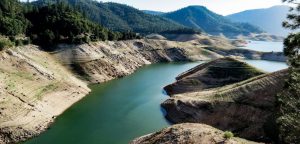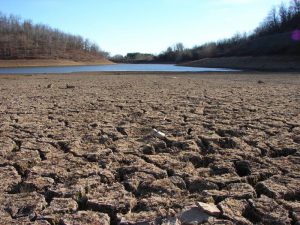In a Congressional hearing this week, US lawmakers began to untangle how drinking water laced with high levels of lead was supplied for more than a year to citizens in Flint, Michigan.
The crisis, one of the most acute threats to public health the US has faced in decades, is also the focus of a federal investigation involving the FBI, a state probe, and lawsuits brought by citizen and environmental groups. All are demanding answers to the same question: what went wrong in Flint, and could it happen in other cities across the country?
The answer is yes, according to water experts. Much of the nation’s water infrastructure is nearing the end of its useful life. Landmark laws meant to protect the surface and groundwater reserves that supply US cities are outdated and insufficient to address new threats to water quality. In addition, climate change and population growth are putting pressure on traditional methods of water management.
In Flint, the story comes down to a potent mix of ageing water pipes and government incompetence. Up until the crisis, Flint’s narrative had followed the arc of the once-mighty industrial towns in America’s northern Rust Belt. Its heyday was in the mid-20th century as a bastion of Michigan’s auto industry, but its population has declined by half since 1960, and for much of the past decade the city’s public administration has been drowning in debt.
Problems with the city’s water began in April 2014, when Flint switched water sources from its longtime supplier, the Detroit water system, and began taking water from the local Flint River in an effort to save US$5 million. But a failure to implement proper corrosion control measures when treating the river water left ageing lead service lines vulnerable to deterioration, leaching lead into the system.
By September 2015, doctors found unsafe levels of lead in the blood of the city’s children, which can cause permanent cognitive and behavioural problems. Flint switched back to Detroit water in October 2015, but the damage was done. Thousands of residents may have been exposed to lead in their drinking water, though the precise extent of lead contamination in the city is still unknown.
“You look at these children, and we know from studies and doctors that exposure to lead is irreversible,” said Danyelle Solomon, director of the Progress 2050 programme at the Center for American Progress, a nonpartisan policy institute in Washington, DC. “Children who are poisoned with lead are seven times more likely to drop out of school, and six times more likely to be involved in the criminal justice system. That’s what’s at stake.”
The Flint crisis is symptomatic of the massive infrastructure challenge facing the US. While the vast majority of communities still have clean, safe water, maintaining that level of service could take an investment of more than US$1.7 trillion by 2050, according to a 2012 study by the American Water Works Association (AWWA). That estimate only includes repairs and necessary expansions to drinking water infrastructure, not wastewater or storm water systems.
“Systematically in this country, we are underinvesting in our urban water infrastructure,” said Glen Daigger, professor of civil and environmental engineering at the University of Michigan. “You can do that for a while, but you can’t do that forever.”
Much of the cost will be borne by water customers through higher water rates. Water is currently priced well below its actual value to society, according to Greg Kail, director of communications at AWWA. That is unlikely to change, but rates will almost certainly increase to more accurately reflect the cost of providing water service.
As Flint so clearly illustrates, the cost of doing nothing is much higher.
“Water quality and the provision of safe and wholesome water is absolutely essential to a well-functioning society,” said Richard Luthy, professor of civil and environmental engineering at Stanford University, and the director of the National Science Foundation’s Engineering Research Center for Re-inventing the Nation’s Urban Water Infrastructure.
He added: “When we fall down on that obligation, then we have serious consequences like Flint, which could have been avoided.”
Dilapidated infrastructure is not the only threat to safe drinking water in the US. Just as the physical components of clean water systems are ageing, so too are the nation’s water protection laws and traditional management paradigms that are ill-suited to address new water supply and water quality challenges.
Spills
A toxic algal bloom in Lake Erie in 2014, for example, shut down drinking water supplies for nearly half a million people in Toledo, Ohio, about 100 miles from Flint. The bloom was fuelled by agricultural runoff, which is largely unregulated by the federal Clean Water Act, the nation’s most important water protection law. Despite repeated calls to update the act, it has not been significantly revised in nearly three decades.
Similarly, a chemical spill in a West Virginia river in 2014 temporarily poisoned the water supply for 300,000 people near the state capital. The spill, from a chemical tank located just 1.5 miles upstream of the city’s drinking water intake, highlighted weaknesses in source water protections and enforcement under the federal Safe Drinking Water Act.
Drought
In the western US, an additional problem is apparent in the five-year drought gripping California. Wells have gone dry in parts of the state, many in poor farming communities where groundwater contamination is also a public health concern. The state issued mandatory water use restrictions for cities last year.
“Climate change, population increase, and ever more demands on our water supply have put us at the limits of what our current system can provide in terms of a reliable and resilient water supply,” Luthy said.
Water trading
The pressure of the drought is forcing cities to rethink how they manage water. Instead of transferring water from far-off sources through miles of state and federal aqueducts, for example, some communities are pursuing ways to capture more stormwater to replenish aquifers.
Water managers in California are also looking to countries such as Australia, which put in place an innovative water trading system to secure water supplies following a severe drought in the early 2000s.
Economic benefit
Changes, while slow, are occurring in Ohio, too. The state last year passed a law regulating manure spreading and fertiliser applications to cut down on the runoff that drives toxic algal blooms in Lake Erie.
“We know we can do this. It’s just that we are not doing it as consistently as we need to from community to community,” Daigger said. “Water is not a cost, it is in fact a benefit when you look at the economic benefit that is created by a good, sustainable, robust system. We definitely want to be efficient in what we do, but the money we’re spending comes back to us, from an economic perspective, many fold. We need to understand that.”







